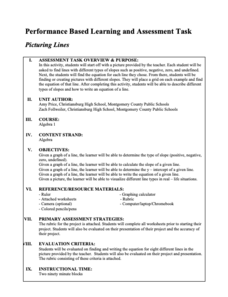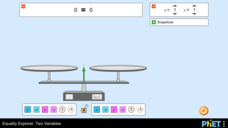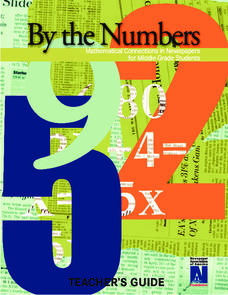K20 LEARN
Didn’t We Already Learn That Pattern? Functions/Arithmetic Sequences
Just how many toothpicks does the pattern take? After watching a video of someone building a pattern with toothpicks, groups create methods to find the number of toothpicks needed to accomplish that task. Groups either use explicit...
Flipped Math
Addition Postulate
Add a little algebra to the geometry. Class members learn about the Addition Postulate for segments and angles. The pupils use their knowledge of solving equations to find lengths of segments and measures of angles. Individuals apply...
Flipped Math
Linear vs. Exponential
Linear or exponential?. Learners watch an informative video comparing situations that may be modeled by either a linear or exponential relationship. Pupils determine the type of relationship and then create a function that models the...
Flipped Math
Unit 3 Review: Systems of Equations
More practice makes perfect. A review packet helps pupils remind themselves of the content of the unit. They determine whether points are solutions to linear equations, graph systems of equations and inequalities, and solve systems of...
Flipped Math
Unit 2 Review: Create and Solve Equations and Inequalities
Start with the basics. Pupils work through a review of the unit on equations and inequalities. Learners begin with solving equations and inequalities with no context, move on to problems that involve a context, and finish with a...
Flipped Math
Literal Equations
All the variables make it look harder. Individuals find out that solving a formula for a variable on interest is no different than solving an equation. Pupils participate during the video presentation by pausing the video and working...
Bowland
Patchwork Cushions
Find out if there are enough squares. Given diagrams for the first four figures in a sequence, pupils try to determine the next figure. Individuals find the number of square and triangle pieces of fabric that are required to make...
Radford University
Tuition Cost Activity
Can I afford to go to college? Small groups design a method to research college tuition for several years and make a prediction of costs in 2025. Classmates plot the the data on a scatter plot and graph the line of best fit to make their...
Radford University
Picturing Lines
Slopes are everywhere—even in houses! Given a picture of a house, learners find lines with positive, negative, zero, and no slopes. Scholars determine the equation of the lines by calculating the slopes and y-intercepts. Class members...
Radford University
Pizza, Pizza!
Ponder the problem of pizza prices. Pupils use provided information about two different pricing schedules for pizza. They create tables of values and functions to represent the pricing schemes, consider domain restrictions, and identify...
Radford University
Green Cravings
Build up a bag of green. Pupils determine the number of green Skittles in a snack bag and come up with a way to determine how many snack bags it would take to create one bag of only green Skittles. Classmates share their methods and...
Radford University
Fuel Efficient Function Activity
Pupils research the five most fuel efficient vehicles of the same type and come up with a way to display the mile per gallon for each vehicle. After choosing a vehicle, scholars create graphs to display miles traveled given the amount of...
Radford University
Staircases and Ramps
Ramp up the study of slope. The class participates in a discussion about the physical aspects of stairs and ramps they encounter. Small groups work together and measure a staircase and corresponding ramp to calculate the slope of each....
Radford University
Exploring Equations through Life Goals
What do I want to do when I grow up? Learners research job categories and determine a career within the category. Using the chosen job, pupils find the hourly wage and calculate future income based on percentage wages. Individuals then...
Radford University
Calculating the Cost: Algebraic Planning for a First Car
Scholars decide which job to take based on the pay. They then research cars to potentially purchase and determine the total cost of the car. Finally, they calculate how long they would have to work to purchase the car along with how much...
Radford University
Movie Projector Cost
Small groups analyze the attendance at a movie theater and determine the amount of money made for per show. Team members calculate the number of shows it would take for a theater to make a profit after purchasing a new digital projector....
Radford University
How do I Choose the Most Cost Efficient Scooter Rental Plan for My Family?
Pupils compare the cost of renting scooters for a family vacation from three different rental places. To help make their decision, scholars create tables, equations, and graphs of the pricing structure. Individuals then determine which...
Radford University
Summer Woes!
Who can afford the computer required to land a summer job? Pupils work in pairs to solve problems related to finding the number of hours needed to work to purchase a given item. Individuals then work on a performance-based assessment to...
Radford University
Linear Equations in Real Word Problems
Make up a story about a linear graph. Scholars identify key features of a linear graph, such as intercepts, domain and range, and slope. They then create a word problem that could be represented by the graphed line.
Radford University
Buying A Car
What is my monthly payment? Scholars research to find the perfect car for them to buy. Using the cost of the car, they determine a down payment and the amount of monthly payments using a zero interest loan. Finally, they investigate what...
Radford University
The Game of Life … Mathematics Style
Make life more organized using mathematics. Scholars get a good look at budgeting and personal finance by using linear equations. They research salary information and costs to develop mathematical models, including equations and graphs.
PHET
Equality Explorer: Two Variables
Solving equations in two variables can't be that much harder than solving equations in one variable. Using a balance interactive, scholars solve equations in two variables. They apply inverse operations by adding -x, -y, or -1 as...
PHET
Equality Explorer
Find the right balance between concrete and abstract thinking. After using interactive balances to explore inverse operations, learners solve multi-step equations with variables on both sides. Of course, they can still use the...
Newspaper Association of America
By the Numbers: Mathematical Connections in Newspapers for Middle-Grade Students
A cross-curricular resource teaches and reinforces mathematical concepts with several activities that use parts of a newspaper. Scholars use scavenger hunts to find the different ways math is used in the paper along with using data...

























